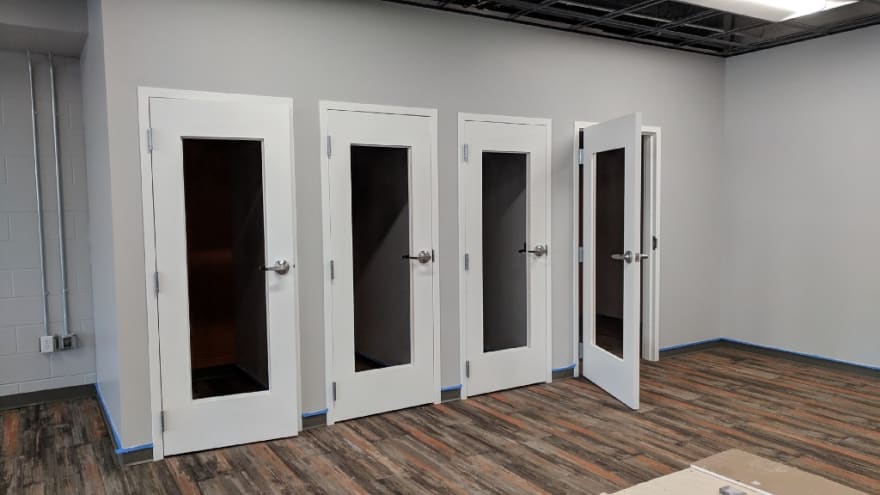As your company grows, you might find yourself struggling to fill your open positions in the local job market. If you already have offices in other regions, hiring remote employees that work out of those offices can be a huge win. The key to making it work is having the right culture and communication structure. I’m a developer in DealerOn’s Grand Rapids, MI office while the majority of my team is based in the Maryland home office. I’ll give an overview of what steps DealerOn has taken as a company to set the stage and soon we’ll look at what it takes to be a remote worker.

Embrace the chat client
A big hurdle that remote workers struggle with is feeling like they’re out of the loop. They’re not there for any of the informal discussions that happen at people’s desks or impromptu meetings that can pop up while a problem is being solved. The old adage stills applies here — out of sight, out of mind.
Fortunately, you can preempt this by integrating a chat client like Slack into your day-to-day operations. Slack moves your discussions and collaboration to a digital audience rather than just to who is in earshot at the time. It also removes the necessity for someone to physically be there to answer a question or offer feedback. If your employees grow accustomed to having discussions in a team specific chat room then all of the team is on equal footing. Remote workers can observe and comment without the friction or interruption of a phone call.
Slack moves your discussions and collaboration to a digital audience rather than just to who is in earshot at the time.
Most people know that when they see two people talking, they should not interrupt and should either wait for the conversation to end or come back later. The problem here is this is inefficient for everyone involved. If you really need an answer you’ll be put in the tough spot of feeling terrible about interrupting or you’re stuck and need to find something else to do while you wait. With Slack, that 1 on 1 conversation could be one of the 4 or 5 I’m having simultaneously. If someone needs to know when my current ticket will be completed, I can give them a quick answer without the social stigma of someone “butting in.” This might sound intimidating but it’s actually very freeing. If someone walks up to your desk, they’re demanding your attention at that moment. If someone sends me a direct message on Slack, I can finish my thought before addressing them.
Another benefit is you’ll naturally reduce the number of meetings where you think to yourself, “this could have been replaced with an email.” A team lead can say something in their channel with an @ tag and everyone in that list will get a notification. If someone has followups to that, it’s instant and visible to everyone.
At this point you might be thinking, “We already have email, isn’t that good enough?” Email and chat are two tools on your workbench but they aren’t interchangeable. Email is more formal by having a subject line, usually a signature, and each one is weighted the same in your inbox. Chat is typically informal and I can add a 👍response with one click and nothing added to your inbox. There’s also no need to curate your chat, whereas my blood pressure rises proportionally with the number I see in Outlook.
Video Conferencing

While chat can cut down on your number of meetings, you’ll never get rid of them entirely. Sometimes you need to get people in a room and discuss something face to face. This is where the difference between local and remote workers is apparent, but there are things you can do to smooth out the burrs.
#1: Use video if at all possible — Humans are visual creatures and it’s easier to understand someone if you can see the facial cues that go along with what they’re saying. It’s also easier sometimes to just nod or throw a thumbs up without breaking the speaker’s momentum.
#2: Rock the mic(s) — Each conference room involved will need a different microphone strategy based on the size of the room. A good starting point is a conferencing phone that includes wireless satellite mics. These can be placed around the table but only pick up people actually sitting at the table. Anyone standing away from the table will sound like one of the adults from the Peanuts cartoons. Pass the mic to them or look at adding hanging microphones around the perimeter of your room. On-table mics are also especially good at picking up taps and bumps so aspiring drummers will have to keep it in check.
#3: Limit the background noise —If the remote workers are dialing in from their desk, they can bring a lot of extra noise whenever they unmute their microphone. A headset/mic combo helps but doesn’t totally eliminate it. One solution that we built into our brand new Michigan office is the inclusion of single person “phone booths.” These soundproofed rooms are great to take your laptop into when you have a meeting with the team and you want to eliminate any background noise. It’s also perfect for a 1-on-1 with your boss when you don’t want to broadcast your business to everyone else.

Change is hard
If you’ve read through all this and still worry that this sounds like a big disruption, fear not! Everything gets easier with repetition. Dialing in to a web conference, learning mic discipline, and adjusting to people working in different time zones will all become second nature after a while. You can also start with a few fake meetings so that everyone can play with their sound levels and get configured without the pressure of trying to actually discuss something work related.
An extra benefit of this setup and preparation is that you’re now prepared if any of your local employees need to work from home. Remote workers can be a huge asset to your team as long as you properly include them. They still can’t participate in the company potluck but I’m confident a research team exists that is focusing on making that a reality.


















